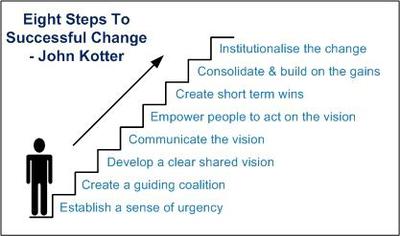Where Kotters 8 Steps Model Gets it Wrong

In a thought provoking article published in 2011 Kayleigh O'Keefe a
former research analyst of CEC Insider - now part of Gartner - suggested
that there are "Three Primary Flaws of Kotter's 8 Steps for Leading Change" and these can be summarised as:
- A one-off event - Kotter's 8 Step Change Model positions change as a one-off event with a defined beginning and a successful end that is reached by adherence to each of the 8 steps. Whereas O'Keefe makes the very valid point that in the current environment of global uncertainty continuous change is now the order of the day.
- Excludes the informal leaders - She challenges Kotter's view that significant change can only come from organisational leaders and says that employees get disillusioned as "leaders make changes to the change they've just touted as the most significant in the company's history!"
- Topdown - Leader instigated topdown change disempowers employees who feel increasingly like pawns on the C-suite's chess board and become stressed as they lose more control of their lives.
Unfortunately the full
article is now no longer accessible on-line. Since then others have
critiqued Kotter's 8 Steps and drawn similar conclusions.
In 2017, Sheffield Hallam University published a useful summary of Kotter's model which includes on pages 6 & 7 some important caveats about the limitations of the model.
My perspective is that there are obvious strengths of Kotter’s 8 Step change Model:
- It sets out a clear leadership roadmap.
- It is energy based and addresses the emotional imperative of momentum.
- It outlines key steps to build and sustain that momentum.
But the weaknesses of the Kotter model are:
- It does not include the essential aspects of change readiness - specifically an analysis of: the key organisational maturity models; the change legacy from previous attempts at change attempts within the organisation; the cultural impacts of the proposed change.
- It does not go far enough in spelling out the specifics of how to achieve clarity of vision and an executable strategy to deliver the envisioned benefits of that vision.
- His focus is on organisational change and does not address the personal transitions that accompany that change.
- The leadership coalition does not include the informal organisation, thus perpetuates the top-down style of centralised command and control leadership.
However, Kotter's 2014 book 'Accelerate' updates the influential 8-step process and does include the informal organisation.
In
2015 Gregory LeStage, a senior figure in the Kotter organisation,
published the following piece which sets out how "Accelerate" develops
the 8 Steps: How Have Kotter's Eight Steps for Change Changed?
To conclude, I stand by what I wrote and published online in 2010 in the Practitioners Masterclass:
- There is no perfect change model.
- Any model is better than no model.
- Change models are not mutually exclusive.
- People will be drawn to an approach – based on one or more models - as is most appropriate to their organisation's circumstances.
Return to: Kotters 8 Step Change Model


